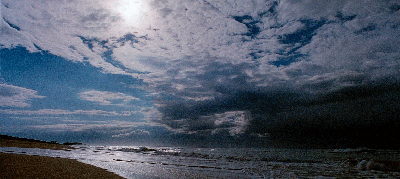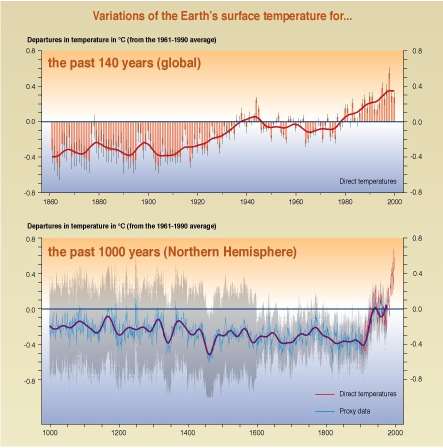
Climate change refers to the variation at a global or regional level over time. It describes the variability or average state of the atmosphere or average weather over time scales ranging from decades to millions of years. These variations may come from processes internal to the Earth, be driven by external forces (e.g. variations in sunlight intensity) or, most recently, be caused by human activities.
If you are not sure of the difference between ‘climate’ and ‘weather’, click on the link to find out: Climate-Weather.
No time to read all this? Visit Facts and Impacts for a one page summary, or listen to four scientists from Columbia University explain future climatic uncertainties. With Peter DeMenocal, Gavin Schmidt, Maxx Dilly and Klaus Lackner.
Find out here
Just as weather patterns change from day to day, the climate changes too. This occurs naturally, driven by internal and external factors. However not all changes are due to natural processes, as we humans have also exerted our influence, which is called anthropogenic climate change.
Through widespread use of land, use of fossil fuels and the building of cities, we have changed our climate. The major technological and socioeconomic shift of the industrial era with reduced reliance on organic fuel, the accelerated uptake of fossil fuels, and broad scale deforestation,means we have contributed to the natural greenhouse effect.
The key areas for concern are those related to variability and extremes, not simply changed average conditions. There is an accumulating body of evidence of observed impacts relating to regional changes, and that these are having fearful effects on the world around us.
There are already people who have become climate refugees, and millions more are expected in the future. Temperatures across the globe are most certainly rising; the 1990s was the warmest decade in the last thousand years. Sea surface temperatures have increased 0.4-0.8°C (0.7-1.4°F) since the late 19 Century, and over the period 1961 to 2003, global ocean temperature has risen by 0.10°C (0.18°F) from the surface to a depth of 700 m.
The world has warmed 0.74°C in the past hundred years and scientists are clear that the world will get warmer this century due to further increases in greenhouse gas concentrations. Global average temperature is forecast to rise 4°C (7.2°F) toward the end of the 21st century.
Warming of a few degrees seems inconsequential compared with day to day, or seasonal variations in temperature. However, in global terms it is much larger than any of the climatic changes experienced during the past 10,000 years, since the rise of agriculture and civilisations. Although the Earth has seen many climatic changes during its 4.6 billion year history, the current changes are spurred by the human burning of fossil fuels.
In addition to warming of the Earth’s surface, there has been an increase in heatwaves, warming of the lower atmosphere and deep oceans. There are fewer frosts, permafrost is melting, glaciers are retreating and sea ice is decreasing. Sea levels have risen 10–20 cm and there is increased heavy rainfall in some regions, and less in others.
Climatic changes over recent decades have already affected some health outcomes. The World Health Organisation estimated, in its “World Health Report 2002”, that climate change was estimated to be responsible in 2000 for approximately 2.4% of worldwide diarrhoea, and 6% of malaria in some middle-income countries. Epidemics of weather and climate-sensitive infectious diseases such as malaria and meningitis will have a devastating effect on human health and socio-economic development and severely overburden health systems in many parts of the world.
The Fourth Assessment Report released in 2007, by the Intergovernmental Panel on Climate Change (IPCC) stated that “there is new and stronger evidence that most of the warming observed over the last 50 years is attributable to human activities”. As seen below, The Report also shows why there is cause for deep concern:
Hydrology and Glaciers – Glaciers are retreating, and snow cover is decreasing (e.g. Davos in the Swiss Alps) with earlier snow melt, and changing snow ecology. There is also reductions in the annual duration of lake and river ice.
Sea Ice – Declining sea-ice extent and thickness.
Animals – Poleward and elevational shifts in range, and alteration in species abundance (e.g. Sea Turtles ). Over a million species are predicted to become extinct by 2050 (e.g. Boyd’s Forest Dragon, Cassowaries ). Changes in phenology (including earlier reproduction and migration), physiological and morphological adaptation.
Plants Change in abundance, diversity, and range, change in phenology (including earlier flowering), change in growth.
The previous Australian Government, whilst not signing the Kyoto Protocol have acknowledged, “The projected global warming of a few degrees in the 21st century would occur at a time that is already one of the warmest for hundreds of thousands of years, with current levels of carbon dioxide not exceeded for the past 420,000 years, and not likely during the past 20 million years”.
A few degrees of global warming will lead to more heat waves and fewer frosts. More wildfires and droughts are expected in some regions of the world with higher rainfalls and resultant flooding in other areas. Higher latitudes of the globe would receive more rainfall while middle latitudes, including parts of Australia, are likely to receive less. For these areas the changes will pose significant problems for water resource management.
Tropical hurricanes and cyclones may become stronger and sea levels will rise over the coming decades. Some low-lying coastal areas and islands are already feeling the effect, and will be more prone to inundation from storm surges.
Human induced climate change is another major stress in a world where natural and social systems are already experiencing pollution, increasing resource demands and unsustainable management practices.
Government’s of the world are slowly responding, but is the response quick enough? At this stage the answer is, no. An international carbon price and developed carbon trading markets must be fast tracked. We must also move quickly to renewable energy as the source for our electricity and transport fuels.


